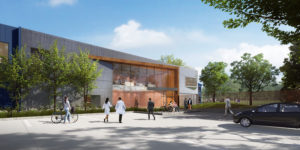
Elements of the Chase Mill will be retained in Berkeley Investments’ conversion of Sasaki’s headquarters into a life science building, including old-growth timber beams, 100-year-old tin fire doors and exposed brick walls. Image courtesy of SGA and Berkeley Investments
Scientists are people too. This may not be a great revelation, but too often new life science buildings lack character and personality.
While elements of the hospitality industry have infiltrated our office spaces, so too should such humanizing elements inform the next generation of laboratory design and development. Creating a unique, inviting and engaging environment for scientific discovery is the approach at 64 Pleasant St. in Watertown Square.
Berkeley Investments in 2021 purchased the 105,000-square-foot former headquarters of Sasaki, a renowned architecture firm that made the collection of older mill buildings its headquarters for more than 40 years. Berkeley, alongside SGA, one of the region’s preeminent life science design architects, is working to transform and adapt the 200-year-old buildings into state-of-the-art laboratories for midsize, fast-growing life science companies.
Berkeley, no stranger to adaptive reuse of mill buildings, has a history of working sensitively with brick-and-beam structures while introducing contemporary elements and rectifying long-deferred MEP, code and accessibility needs. Yet every project poses its own unique challenges and opportunities, and here the team saw the potential to focus the building’s next generation on science and technology.
Next Step in a Long Evolution
The existing historic mill building, formerly known as Chase Mills, has seen numerous industrial incarnations over its long history; a paper mill, garment manufacturer, paper bag factory, screw & machining products warehouse and, most recently, creative office space. Berkeley and SGA see the building’s future as the next step in its commercial evolution, one that is absolutely necessary in order to preserve these historically significant structures that have sat along the banks of the Charles River for centuries.
The team’s creative investment of time and capital are needed to ensure the buildings can be utilized for another 100 years. One of the most challenging requirements, as identified by SGA, is the need to provide the requisite floor-to-ceiling clear height suitable for new life science tenants.
To achieve these critical clearances, along with meeting the stringent floor loading and vibration requirements, the team is lowering the first floor by excavating more than 4 feet in select areas, introducing structural steel reinforcing and pouring a new structural concrete floor slab.
Additionally, the team creatively reinforced key structural elements to facilitate the installation of state-of-the-art mechanical infrastructure to support the building’s research program. In essence, the team is building a brand-new building within an old building.

Morgan Pierson
Preservation Includes Old-Growth Beams
While challenging from a design and construction standpoint, the building’s constraints extend an opportunity to deliver a highly distinctive and authentic atmosphere to the scientists who will work here.
As it relates to performance and function, these spaces are comparable to a newly-built environment, yet offer a unique character that speaks to the building’s heritage. In addition to transforming the interior spaces, preserving and exposing the elements that make it such a unique and desirable place to work is a key strategy in celebrating the building’s character.
Old-growth timber beams are being stripped of paint and left in place wherever possible. Hundred-year-old tin fire doors are being repurposed in the building’s amenity zones. The existing brick walls will remain exposed in the open office spaces. These are the elements that can never be replicated in new construction and that will make this a one-of-a-kind environment for leading science companies.

John Sullivan
Another driver allowing for such a large reinvestment is Watertown itself. The municipality and broader community championed the idea of preserving the site while also allowing for upgrades and alterations that encourage life science companies to relocate to Pleasant Street. Watertown’s forward thinking and willingness to work with developers and biotech companies has earned it a Gold rating status from MassBio, and more importantly resulted in the creation of one of the region’s strongest and most exciting life science clusters.
Lastly the notion of “speed-to-market,” a sentiment strongly ingrained in the development team, was critical to this process to respond to the immediate demand for space of this type, size and quality in the Watertown cluster. In the context of navigating a complicated and constrained property, the team is constantly innovating to meet these demands in an accelerated timeline. This innovation is focused on transforming this unique property into a place for scientific exploration, research and discovery. Berkeley and SGA believe that future breakthroughs will occur in an environment that is truly unique – providing infrastructure for cutting-edge research while also embracing the industrial heritage of Watertown’s past.
Morgan Pierson is director of development at Boston-based Berkeley Investments and John Sullivan is president of architecture of SGA.





